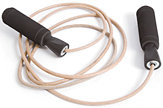To Your Health
December, 2008 (Vol. 02, Issue 12) |
|
|
Body-Weight Training
Otherwise known as "gravity training," body-weight training involves exercises against the gravity resistance of your own body. Examples include pushups, sit-ups, chin-ups, squats and lunges. The great thing about body-weight training is that regardless of age, strength or experience level, everyone can do it, and everyone can benefit from it. It doesn't matter whether you are a top-level athlete looking to enhance your competitive skills or a couch potato who hasn't exercised in years. Body-weight training will deliver results. You can get into great shape without wasting time going to the gym, and it doesn't cause the sore knees, backs and shoulders that often result from heavy lifting.
Plyometrics
Plyometrics is a form of training that uses explosive movements such as jumps, skipping, bounding, jumping rope, hopping, lunges, jump squats and clap push-ups to develop muscular power. It acts on the muscular and neurological systems to increase your power output. These quick, powerful movements increase your stamina and metabolic rate. When mixed with resistance exercises, it can significantly elevate your heart rate, replacing the need for traditional cardiovascular work. If you suffer from knee, hip or back pain, be careful when introducing plyometrics, as it can be rough on your joints.
 A Stability Ball
A Stability Ball
Exercise (stability) balls focus on core and functional training, which involves strengthening the torso for better workouts and fewer injuries. Fitness experts know it's one of the best ways to strengthen the abs and back to increase stability. Exercise balls challenge muscles by putting your body in an unstable environment. When you lie on the ball, your legs and abs immediately contract to keep you from falling off. Add an exercise (like a chest press or a crunch) and you've just increased the intensity of the movement. Exercise balls are versatile enough to use for just about anything. Make sure to choose the proper ball for your height and body weight.>
A Weighted Fitness Bar
This is a classic fitness tool: a simple, one-piece, solid steel, weighted fitness bar covered in rubber. It is very user friendly and extremely versatile. You can do a wide variety of workouts, including strength and conditioning, circuit and interval, martial arts, sports conditioning, balance and alignment, Pilates- and yoga-based workouts, and flexi-bility training. It has a beginner-level weight as low as 3 pounds to an advanced-level weight of 36 pounds. It replaces the need for heavy Olympic-size bars that take up too much space and are not practical for home use.>
A Medicine Ball
A medicine ball is a weighted ball between 3 and 25 pounds. Medicine ball exercises are an excellent way of training the core muscles to develop power. They help keep exercise fun by making the same old boring routines dynamic and interesting. It's important to remember, though, that unlike weight training, you shouldn't aim to keep increasing the weight to get results. When you see the benefits of improved balance, power and stability, you will be motivated to continue with this style of training. Keep your workouts fun - mix in a couple of medicine ball exercises and see what happens. You will be pleasantly surprised with the results.
 A Jump Rope
A Jump Rope
Jumping rope is a tried and true method for improving conditioning and coordination. If you have never jumped rope before, you can expect a challenge. The rope can be very frustrating to a beginner. You will not become proficient with the rope overnight. It takes time and practice. Many athletes get frustrated and quickly find alternative conditioning tools. Do not allow your frustration to interfere with your quest for a better body. Jumping rope increases agility, quickness and endurance. When mixed in with a strength conditioning program, it can be the secret weapon in the battle to achieve a lean physique.

